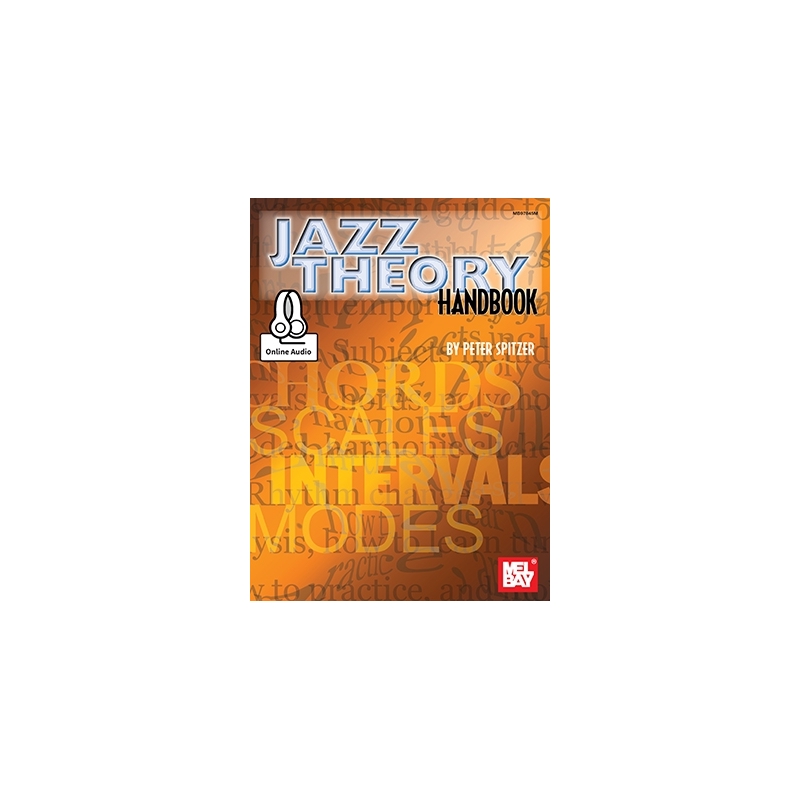Jazz Theory Handbook is a complete guide to all the essential topics of jazz theory, suitable for all treble instruments. Its approach is clear and concise, realistic and practical. This book will help you to understand how contemporary jazz players think, and to apply theory concepts in your own playing. Subjects are introduced progressively, with each new one based on those introduced before. Topics include chord building, harmonic movement, modes, II-V-I licks, polychords, blues, rhythm changes, how to learn tunes, practice techniques, playing outside, and more. All of the book's musical examples are performed on the accompanying audio, along with sample solos and 3play-along tracks with a great rhythm section. Jazz Theory Handbook is designed for both self- study and classroom use. Audio download available online.
CONTENTS
- Introduction
- Chapter 1 - Intervals and Scales
- 1. Half steps and whole steps
- 2. Major scales
- 3. Circle of fifths
- 4. Intervals-how they are named
- 5. Hearing intervals
- 6. Minor scales
- 7. Other scales you should know
- 8. Transposing
- 9. Exercises
- Chapter 2 - Chord Building
- 1. Triads
- 2. Seventh chord vocabulary
- 3. Seventh chords in major: Roman numeral notation
- 4. Seventh chords in minor
- 5. Extensions and avoid notes
- 6. Polychords/upper structures
- 7. Exercises
- Chapter 3 - Chord Movement: Harmonic Cliches
- 1. V to I
- 2. Circle of dominants
- 3. IlVI
- 4. Circle of fifths within a key
- 5. Deceptive cadences
- 6. Common tones
- 7. Secondary dominant
- 8. Substitute dominant
- 9. Pivot chords
- 10. IV m and b Vlldom, modal interchange
- 11. Turnarounds, tags, vamps
- 12. Exercises
- Chapter 4 - Modes and Chord Scales
- 1. Scale tones as chord extensions
- 2. Modes of major
- 3. Modes of major, continued
- 4. Modes of melodic minor
- 5. Whole tone and diminished scales
- 6. Bebop scales
- 7. Pentatonic scales
- 8. Exercises
- Chapter 5 - Blues
- 1. Blue notes and the blues scale
- 2. Basic blues progression
- 3. Dominant I and IV
- 4. Variable third
- 5. Bebop blues
- 6. Minor blues
- 7. Bird blues and other variations
- 8. Sample solo
- Play-along track-Blues in F
- Chapter 6 - Rhythm Changes
- I. Chord chart and analysis
- 2. Improvising on Rhythm changes
- 3. Variations on the progression
- 4. Sample solo
- Play-along track-Rhythm changes in Bb
- 5. Exercises
- Chapter 7 - Approaches to Improvising
- 1. Beyond theory
- 2. Outside playing
- 3. About originality
- 4. Exercises
- Chapter 8 - Learning Tunes
- 1. Suggestions for learning tunes
- 2. Tips on analyzing harmony
- 3. Form
- 4. Interpreting lead sheets
- 5. Memorizing tunes
- 6. Exercises
- Chapter 9 - Sample Analysis:
- After You've Gone
- 1. Lead sheet and analysis
- 2. About this tune
- 3. Lyrics
- 4. Bar-by-bar comments
- 5. Sample solo
- Play-along track-After You've Gone in C
- 6. Exercises 1
- Chapter 10 - Suggestions for Further Study
- 1. Listen, practice, analyze, perform
- 2. Practice routines
- 3. Exercises for basic technique
- Appendix A - II V I licks
- Appendix B - The logic behind the chord scale system
- Appendix C - Solos for Bb and Eb instruments: chord charts for play-along tracks
- Appendix D - Selected bibliography



